Treblinka Gas Chambers

Treblinka Gas Chamber – Drawing by E. Rosenberg
The gas chambers of the three Aktion Reinhardt death camps, Belzec, Sobibor and Treblinka, as recalled by eyewitness accounts will be described in a series of articles. The individual developments in each camp will be traced. It is worth noting that in each of the three camps, the original gas chambers were found to be inadequate to the task of killing hundreds of thousands innocent Jewish men, women and children. These facilities were by and large primitive affairs, not like the massive, large-
SS men said it was to be a bath. Only later on, when the building was almost completed, I realised that it was to be a gas chamber. What was indicative of it was a special door of thick steel insulated with rubber, twisted with a bolt and placed in an iron frame; and also the fact that in one of the building compartments there was put an engine, from which three iron pipes led through the roof to the three remaining parts of the building. A specialist from Berlin came to put tiles inside and he told me that he had already built such a chamber elsewhere.
Abraham Krzepicki was deported from Warsaw on 25 August 1942, and he spent eighteen days in Treblinka before escaping and returning to Warsaw. His description of the gas chambers at the death camp, are amongst the earliest recorded:
But the longish, not too large brick building standing in the middle of the death camp had a strange fascination for me: this was the gas chamber. Before I left the area, I felt I had to obtain a glimpse of this, the most terrible part of the camp where the sinister crime was perpetrated on the Jews. I had already come quite close to it several times when I and others had been carrying water for the lime and clay from the well which stood right next to the building.... only as we were returning from our midday meal and our column halted for a while, did I sneak away from them and move towards the open door of the gas chamber. I think I have already noted that this building was surrounded by a wooded area. Now I noticed that, spread over the flat roof of the building, there was a green wire net whose edges extended slightly beyond the building's walls. This may have been for protection against air attacks. Beneath the net on top of the roof I could see a tangle of pipes. The walls of the building were covered with concrete. The gas chamber had not been operating for a week. I was able to look inside through one of the two strong whitewashed iron exits which happened to be open. I saw before me a room which was not too large. It looked like a regular shower room with all the accoutrements of a public bathhouse. The walls of the room were covered with small white tiles. It was very fine, clean work. The floor was covered with orange terra cotta tiles. Nickel-
Jankiel Wiernik was deported from Warsaw on 23 August 1942, and he was involved in the construction of the larger second gas chambers in Treblinka, as he was a master craftsman. He was a leading figure in the prisoner uprising and escaped during the revolt on 2 August 1943. He provided a written account of his time in Treblinka under the title 'A Year in Treblinka.' He wrote:
When I arrived at the camp, three gas chambers were already in operation; another ten were added while I was there. A gas chamber measured 5 x 5 meters and was about 1.90 meters high. The outlet on the roof had a hermetic cap. The chamber was equipped with a gas pipe inlet and a baked tile floor slanting towards the platform. The brick building which housed the gas chambers was separated from Camp No 1 by a wooden wall. This wooden wall and the brick wall of the building together formed a corridor which was 80 centimetres taller than the building. The chambers were connected with the corridor by a hermetically fitted iron door leading into each of the chambers. On the side of Camp No.2 the chambers were connected by a platform four meters wide, which ran alongside all three chambers. The platform was about 80 centimetres above ground level. There was also a hermetically fitted wooden door on this side. Each chamber had a door facing Camp No. 2 – 1.80 by 2.50 meters – which could be opened only from the outside by lifting it with iron supports and was closed by iron hooks set into the sash frames, and by wooden bolts. The victims were led into the chambers through the doors leading from the corridor, while the remains of the gassed victims were dragged out through the doors facing Camp No.2. The power plant operated alongside these chambers, supplying Camps 1 and 2 with electric current. A motor taken from a dismantled Soviet tank stood in the power plant. This motor was used to pump the gas which was let into the chambers by connecting the motor with the inflow pipes.
Eliahu Rosenberg who was deported from Warsaw to Treblinka during September 1942 worked in the Totenlager, as a cleaner of the chambersand as a corpse carrier, described the small gas chambers:
The first thing which appeared before our eyes was a barn-
As the transports from the Warsaw ghetto continued and from other parts of the Generalgouvernement it became evident during August 1942 that the three gas chambers were inadequate. The camp under Dr Irmfried Eberl was in constant chaos and breakdown with thousands of un-
SS–Unterscharführer Erwin Lambert the gas chamber construction expert from T4 in Berlin played a key role in the construction of the new gas chambers and he testified after the war:
At Treblinka I laid the foundations for the large gas chambers. I had some Jewish prisoners and some Ukrainians in my work force. The Ukrainians were guards, but there they worked as masons and carpenters. We never officially spoke of gas chambers but of shower rooms. We must have worked for six to eight weeks on that job. In addition to building the large gas chambers, I also did other construction jobs. I remember that a baker's oven was built, a stable, and a detention block for the guards. I got the building material from ruined buildings near the camp. I was given Jewish prisoners for this work Jankiel Wiernik recalled the construction of the new gassing facility:
It turned out that we were building ten additional gas chambers, more spacious than the old ones, 7 by 7 meters or about 50 square meters. As many as 1,000 to 1,200 persons could be crowded into one gas chamber. The building was laid out according to the corridor system, with five chambers on each side of the corridor. Each chamber had two doors, one door leading into the corridor through which the victims were admitted; the other door, facing the camp, was used for the removal of the corpses. The construction of both doors was the same as that of the doors in the old chambers.

The Corridor in the New Gas Chambers ( CAD by Peter Laponder - ARC)
The building, when viewed from Camp No. 1, showed five wide concrete steps with bowls of flowers on either side. Next came a long corridor. There was a Star of David on top of the roof facing the camp, so that the building looked like an old-
Over in Camp 2 there was also the 'bath'. It was a large concrete building standing on a cement platform. On its roof and visible from a distance was a wooden Star of David. Running through the middle of the building was a corridor. The entrance was covered with a red curtain. Off the corridor there were doors leading to small cubicles into which the arrivals from the transport were introduced. Outside over the platform, there were large openings covered by panels hinged at the top and fastened with steel bands. Inside the cubicles smooth tiles covered the slightly slanted floors and went halfway up the walls. On the ceiling a few shower heads were mounted. There was also a small window in the middle of the ceiling. As mentioned before, the people leave all their belongings in Camp 1. Everyone is undressed there. The women already naked, are seated on a long bench and their hair is cut off. This is accomplished by about forty 'hairdresers'. The hair is then cleaned with steam, using a steam kettle brought especially for this purpose. The hair is then packed in bales, and sent out along with the clothing and other wares.
The victims come into Camp 2 already naked and shorn, and are immediately squeezed into the cubicles. There is no more division: men, women and children are all pressed together in the small cubicles so tightly that this alone would be enough to suffocate them. The doors are hermetically sealed, the motors start to work. The air from inside is sucked out and fumes from burnt gasoline forced in. The cries from inside can be heard for about for about ten minutes and then it becomes quiet. The entire process, from the arrival at the camp to the oven lasts only about half an hour. Most of the victims in the cubicles start to haemorrhage. A German controls the progress of the work through the little window in the ceiling. When he is sure that everyone inside is dead, he opens the side panels, and the corpses fall out onto the cement platform. An elderly Jew from Czestochowa called the 'dentist' checks the bodies for gold or metal teeth, which he pulls out.
Abraham Bomba was deported from Czestochowa to Treblinka where he arrived on 30 September 1942 and he worked as a barber for a short time in the Totenlager. He was interviewed by the USHMM on 28 August 1990:
They took us into the gas chamber..... in the gas chamber before they gassed them. There were benches about 20 benches maybe less. And on a row of benches women were sitting and the barber went through cutting hair, with me cutting hair. The gas chamber –how it looked? Very simple. Was all concrete. Was no windows. There was nothing in it. Besides on top of you, there were wires and it looked like, you know the water going to come out from it. Had two doors – steel doors. From one side and the other side. The people went into the gas chamber from the one side. Like myself I was in it doing the job as a barber. When it was full the gas chamber, the size of it was, i would say 18 by 18 or 18 by 17.
Yekhiel Meyer (Chil) Rajchman was deported from Ostrow Lubelski to Treblinka during October 1942. He worked in the Corpse Carrying Brigade then as a 'dentist' in the Totenlager. He recalled that:
It is worth mentioning that at the time I began working in the death camp, there were two gassing structures in operation. The larger one had ten chambers, into each of which as many as four hundred people could enter. Each chamber was 7 meters long by 7 meters wide. People were stuffed into them like herrings. When one chamber was full, the second one was opened, and so on. Small transports were brought to the smaller structure, which had three gas chambers, each of which could hold four hundred and fifty to five hundred persons. In that structure the gassing would last about twenty minutes, while in the more recent structure it would last about three quarters of an hour.
SS–Oberscharführer Heinrich Arthur Matthes was in charge of the Upper Camp (Totenlager) testified at the Treblinka trial held in Dusseldorf during 1965:
The people who were brought through the passage were forced to enter the separate (single) gas chamber. Later, in summer 1942, the new gas chambers were built. I think that they became operational only in the autumn. All together, six gas chambers were active. According to my estimate, about 300 people could enter each gas chamber. The people went into the gas chambers without resistance. Those who were at the end, the Ukrainian guards had to push inside. I personally saw how the Ukrainians pushed the people with their rifle butts. The gas chambers were closed for about thirty minutes. Then Schmidt stopped the gassing, and the two Ukrainians who were in the engine room opened the gas chambers from the other side.
Pavel Leleko, a Ukrainian trained at Trawniki, was interrogated on 20 February 1945 about his service in Treblinka, he stated the following about the old and new gas chambers:
A road led from the undressing rooms to the third section of the 'death camp' and terminated at the building where the extermination of people took place. Flowers grew right by in long boxes. There was no door at the entrance. Instead of it there was a heavy hanging made from a rug. Beyond it started a narrow passage which ended at the opposite wall. To the right and to the left of the passage there were five doors that closed hermetically and led into the special chambers where the poisoning took place. The chambers were about six meters long and as wide, about two to five – three meters high. In the centre of the ceiling there was an electric light bulb in which there was no wiring and there were two 'shower' heads through which poisonous gas was fed into the chamber. The walls, floor and ceiling of the chamber were of cement. On the opposite side to the entrance door there was another, likewise hermetically closing door, through which the bodies of the poisoned people were removed. As many as 500 men, women and children were pushed into the chambers indiscriminately. Eight chambers out of the ten existing in the gas chamber building were used to poison people. In the two remaining ones, there were two powerful German engines, about 1.5 meters high – two engines in all. Each engine fed gas to four gas chambers. Some 20 meters from the above mentioned gas chamber building stood the building of the old gas chambers, which contained only three gas chambers. This building functioned until 1943. But as it was unable to handle the enormous number of people brought by the Germans to the 'death camp,' the new, large gas chamber building that I have described above was built.
Pavel Leleko stated during interrogations on the following day, the 21 February 1945:
After the chambers were filled they were slammed shut with hermetically sealed doors. The motorists Marchenko and Nikolay would turn on the motors. Through pipes, exhaust gas was fed into the chambers. The process of asphyxiation began. Some time after starting the motor, the motorists would look into the chambers through special observation slits along side each door, to see how the killing process was going. When questioned what they see there, the motorists answered that the people are writhing, twisting one another. I also tried to look in through the little window into the chamber, but somehow I did not succeed in seeing anything. Gradually the noise in the chambers subsided. After about fifteen minutes the motors were turned off, an unusual calm set in.
In January 1942 the SS-
The next day – 19 August 1942 – we drove in the car of Hauptmann Wirth to Treblinka, 120 kilometers north-
SS–Unterscharführer Franz Suchomel recalled how Treblinka descended into chaos under Dr Eberl, during August 1942 and how the small gas chambers were replaced by a larger facility on the orders of Christian Wirth:
The gas chambers couldn't handle the load. The small gas chambers. The Jews had to wait their turn for a day, two days, three days. They foresaw what was coming. They foresaw it. They may not have been certain but many knew. There were Jewish women who slashed their daughters' wrists at night, then cut their own. Others poisoned themselves. They heard the engine feeding the gas chamber. A tank engine was used in that gas chamber. At Treblinka the only gas used was engine exhaust. Zyklon gas – that was Auschwitz.
The new gas chambers were built in September 1942. Hackenholt and Lambert supervised the Jews who did the work, the bricklaying at least. Ukrainian carpenters made the doors. The gas-
Note: That Gerstein agrees with Pavel Leleko regarding there were eight gas chambers, though Matthes the head of Camp 2 thought it was only six. Suchomel thinks it was eight but that only four were used, as body disposal was too complicated, which is difficult to believe, that the Germans went from using three chambers to four. It is noticeable that all the Jewish eyewitnesses state that there were ten chambers. Yankiel Wiernik was a master craftsman, and was involved in the construction. It is difficult to understand why there should be so much confusion as to the actual number of gas chambers in the facility built during the autumn of 1942.
Rudolf Höss the commandant of Auschwitz visited Kulmhof (Chelmno) and Treblinka extermination camps, probably during September 1942, where he was looking to see the cremation operations in the field regarding body disposal after mass killings:
I myself have only seen Kulmhof and Treblinka. Kulmhof had ceased to be used, but in Treblinka I saw the whole operation. The latter had several chambers, capable of holding some hundreds of people built directly by the railway track. The Jews went straight into the gas chambers without undressing, by way of a platform which was level with the trucks.
A motor room had been built next to the gas chambers, equipped with various engines taken from large lorries and tanks. These were started up and the exhaust gases were led by pipes into the gas chambers, thereby killing the people inside. The process was continued for half an hour until all was silent inside the rooms. In an hour's time the gas chambers were opened up and the bodies taken out, undressed and burnt on a framework made of railway lines.
Avraham Lindwasser who was deported from Warsaw to Treblinka where he arrived on 28 August 1942, worked as a dentist in the Upper Camp. He gave evidence at the Eichmann trial in 1961:
For a while we worked at the gas chambers, inside the corridor of the small gas chambers, we could also see the gas chambers at the end. On one occasion, i was even taken – again by that Matthes – to the first camp, in order to fetch pairs of forceps for extracting teeth, since extra men had been added to our group. We passed by the large chambers and, on the way back, I saw a big curtain at the entrance to the large chambers, a curtain used to cover the Ark containing the Torah Scrolls with the Shield of David on it, and on the curtain there was the inscription: 'This is the gate of the Lord, through which the righteous shall enter.' It was a curtain for the Ark-
Pinchas Epstein was deported from Czestochowa to Treblinka on 22 September 1942, he was selected to work in the Totenlager as one of the corpse carrying work brigade. At the trial of John Denjanjuk in Jerusalem which began on 16 February 1987, he testified:
We heard cries, screams – unbelievable-
Eliahu Rosenberg recalled the gassing procedure
The people arrived from this famous 'Himmelstrasse,' which led from Camp 1 to Camp 2. In the 'Himmelstrasse,' SS men, the entire staff of Camp 2, stood there with dogs, with whips and bayonets. The people walked past in silence. That was at the beginning, in summer 1942. They did not know where they were going. When they entered the gas chambers, two Ukrainians stood next to the entrance – one was Ivan and the other was Nikolai. They introduced the gas... the gas came from an engine ... it was Ropa gas. Yes, it was gas from an engine. They put in Ropa, which was a kind of oil, a crude oil, and the fumes entered the gas chambers.... four hundred people were put into one small gas chamber. When they shut them in, we were standing on the outside. We only heard cries of 'Shema Yisrael, Father, Mother,' thirty –five minutes later they were dead. Two Germans stood there listening to what was going on inside. Afterwards they said, 'Alles schlaeft´(All are sleeping). They ordered us to open the door. We opened the door and removed the bodies.
Eliahu Rosenberg at the John Demjanjuk trial recalled:
Next to Ivan's work area were barrels of fuel, and Rosenberg was given permission to retrieve a bucket of diesel fuel to pour on the corpses.
Grigoriy Skydan, a Trawnikimanner at Treblinka,was interrogated on 26 May 1950 and he stated that:
The people screamed, beat at the door, attempted to break out, and here Shaleyev and Marchenko turned on the diesel and fed the exhaust gas from it into the gas chamber; and after about fifteen minutes the people in the gas chamber would die. Special crews took the dead to oven-
Nikolay Shalayev testified at the Voronezh Military Tribunal on 20 December 1951:
In the bath house where the engine room was located, there were with me two Jews, two Germans and one more Soviet citizen, a Ukrainian who along with me, guarded the Jews and supervised their work. The Jews re-
Nikolay Malagon, a Ukrainian, trained at Trawniki was interrogated on 18 March 1978:
I saw that trains carrying citizens of Jewish nationality, men, women and children, old men and women arrived regularly at the camp. These citizens were driven into a special barrack, where they removed all their clothing and threw their valuables into specially placed suitcases. Then they were chased naked to the gas chambers through special passage made of barbed wire covered with pine branches. Pipes carrying exhaust gas from running diesel motors were installed in the gas chambers and the people inside perished. The dead were then thrown into special pits and later burnt on pyres.............Near the diesel engines by the gas chambers there worked a guard by the name of Marchenko.
CAD TREBLINKA GAS CHAMBERS
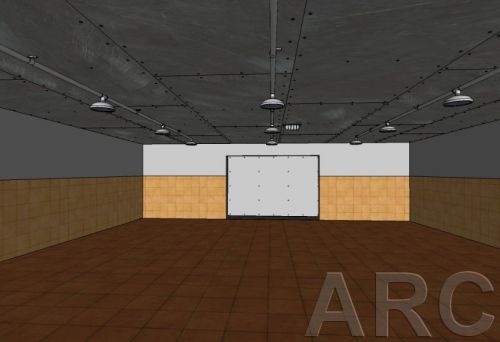
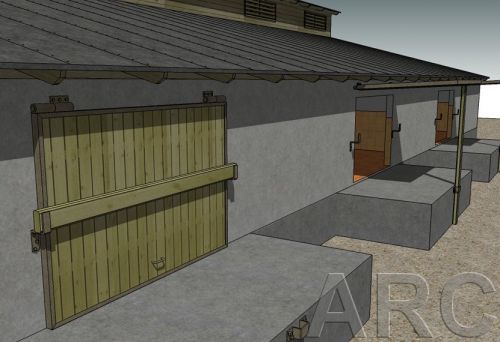
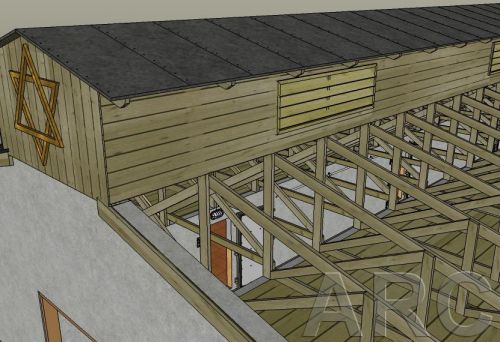
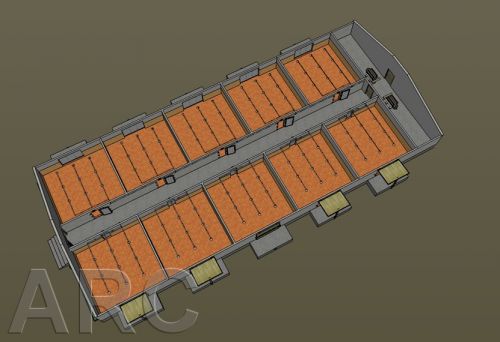
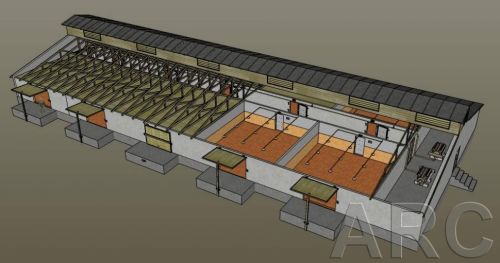
All CAD Images by Peter Laponder from the ARC Website
Sources
Y. Arad, Belzec, Sobibor, Treblinka, Indiana University Press, Bloomington and Indianapolis, 1987
G. Sereny, Into That Darkness, Pimlico, London 1974
C.Webb & M. Chocholaty, The Treblinka Death Camp, Ibidem-
Rudolf Höss, Commandant of Auschwitz, Pan Books, London and Sydney 1980
T. Teicholz, Ivan the Terrible – The Trial of John Demjanjuk, Macdonald & Co, London & Sydney 1990
The Nizkor Project (Complete Eichmann Trial Transcripts) Website
Office for Special Investigations at the Department of Justice, Washington DC, United States of America
USHMM RG -
Image Of the Treblinka Gas Chamber – Drawing by Elihau Rosenberg – Chris Webb Archive
CAD by Peter Laponder - ARC Website
© Holocaust Historical Society February 11, 2023

